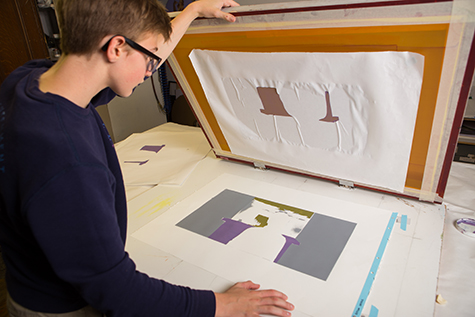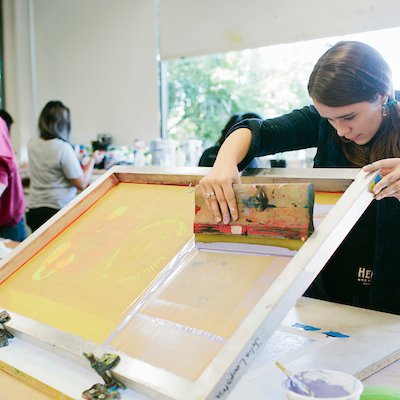Discover the Different Types of Screen Printing Techniques for Your Next Job
Screen printing uses a diverse variety of methods that can improve any creative task. From standard approaches like serigraphy to modern-day technologies such as direct-to-garment printing, each technique has its distinct benefits. Specialty options, consisting of environmentally friendly and metal inks, introduce also extra possibilities. Recognizing these methods can significantly affect the last result. The challenge lies in picking the most suitable technique for particular requirements and wanted effects. What aspects should one think about?

The Basics of Screen Printing
Screen printing may seem complicated, it is essentially a simple process that includes transferring ink through a mesh screen onto various surfaces. The method starts with the creation of a pattern, which specifies the design to be printed. This stencil is affixed to a mesh screen, commonly made from polyester or nylon. As soon as the pattern is in location, ink is put on the screen and pushed with the mesh making use of a squeegee, leading to the desired pattern being printed on the underlying product.
Screen printing can be done on a vast array of substratums, consisting of paper, plastic, and fabric, making it a versatile option for various jobs. The procedure enables complex layouts and vivid colors, making it preferred in markets such as advertising, art, and style. Comprehending these basics equips individuals with the fundamental expertise required to check out advanced strategies in screen printing.
Conventional Screen Printing Techniques
Typical screen printing methods have actually been employed for centuries, maintaining the craftsmanship and creativity of this approach. This strategy makes use of a mesh screen to transfer ink onto a substratum, such as fabric or paper, permitting resilient and vivid styles. The process starts with developing a pattern, which obstructs specific locations of the screen to manage where the ink will be used.
One prominent method is serigraphy, typically utilized for restricted editions and creative prints. One more is making use of water-based inks, which are green and give a soft feeling on textiles - 10:9 Design Company. Additionally, standard methods can consist of manual printing, where artisans use ink with a squeegee, making certain accuracy and interest to information
These strategies continue to be valued in the market for their responsive top quality and the distinct textures they produce, attracting both designers and consumers that value the heritage of screen printing.
Digital Screen Printing Innovations
As the demand for faster manufacturing and modification in the printing market has surged, electronic screen printing advancements have emerged as a game-changer. This modern technology mixes conventional screen printing methods with electronic processes, permitting for quick prototyping and intricate styles that were formerly tough to achieve. One significant advancement is the introduction of direct-to-garment (DTG) printing, which helps with high-quality, full-color prints on numerous fabrics without the requirement for displays. Additionally, innovations in ink formulations have actually resulted in environmentally friendly options that preserve vibrant shades while lessening ecological impact. Making use of automated systems further improves manufacturing, minimizing labor expenses and improving accuracy. These developments not just cater to little set orders and tailored layouts however likewise permit quicker turn-around times, making them perfect for organizations concentrated on meeting client demands in a busy market. Digital screen printing, consequently, represents an essential evolution in the domain of printing techniques.
Specialty Screen Printing Methods
Checking out specialized screen printing techniques discloses a varied variety of methods that push the boundaries of creativity and functionality in the printing sector. Among these, glow-in-the-dark inks give an unique visual result, making layouts come active in low-light conditions. Metallic inks, known for their shimmering finish, include a touch of high-end to printed materials. One more innovative method is discharge printing, which gets rid of color from the fabric as opposed to including ink, causing a soft, classic feeling. High-density printing produces a raised texture on the surface, enhancing responsive interaction. Furthermore, water-based inks are getting popularity for their vibrant shades and minimized environmental influence. Each of these specialized methods caters to specific layout demands, enabling brand names and artists to develop standout items that resonate with their target markets. By leveraging these techniques, services can boost their screen printing projects to brand-new heights, guaranteeing remarkable perceptions.
Eco-Friendly Screen Printing Options
Environment-friendly screen printing alternatives are acquiring grip as the industry changes towards sustainability. Sustainable ink selections and using biodegradable materials are vital elements in reducing the ecological impact of the printing procedure. By taking on these practices, screen printers can add to an extra sustainable future while keeping top notch results.
Lasting Ink Choices

Biodegradable Products Use
As the screen printing sector evolves, the incorporation of naturally degradable materials is ending up being significantly vital for environmentally conscious practices. Makers and designers are currently checking out inks and substratums made from all-natural, sustainable resources that decay more efficiently than traditional equivalents. These eco-friendly choices reduce plastic waste and decrease ecological influence, lining up with the growing need for sustainable products.
Typical instances include water-based inks and natural cotton materials, both of which lessen harmful chemicals and promote eco-friendliness. Brand names that adopt these products usually improve their market charm, bring in customers that focus on sustainability. As awareness of environmental issues remains to rise, the shift in the direction of biodegradable products in screen printing is likely to obtain momentum, promoting a greener sector standard.
Selecting the Right Technique for Your Project
Exactly how can one establish one of the most appropriate screen printing strategy for a details job? The decision hinges on numerous elements, consisting of the material to be printed on, the complexity of the layout, and the preferred production volume - click here 10:9 Design Screen Printing Texas. Direct-to-garment printing is optimal for detailed designs with various colors, while standard screen printing succeeds for larger runs of easier graphics.
Furthermore, factor to consider of the end-use of the printed thing is important. For exterior applications, methods that provide sturdiness and weather condition resistance, such as plastisol ink, might be chosen. On the other hand, environmentally-conscious tasks might take advantage of naturally degradable products or water-based inks.
Eventually, comprehending the project's distinct demands permits an informed choice, making certain both visual allure and functional durability. By reviewing layout intricacy, product compatibility, and manufacturing range, one can efficiently choose the most suitable screen printing technique to meet their project's objectives.
Regularly Asked Concerns
What Is the Background of Screen Printing?
Screen printing came from ancient China around 1000 AD, evolving through Japan and Europe. By the 20th century, it came to be preferred in business art and fashion, reinventing exactly how styles were produced and distributed worldwide.

Exactly how Do I Prepare Artwork for Screen Printing?
To prepare art work for screen printing, one need to assure high resolution, make use of a suitable color mode, create separate layers for each shade, and transform message to outlines, assuring compatibility with the printing procedure and wanted end result.
What Products Are Ideal for Screen Printing?
The ideal products for screen printing consist of high-grade inks, sturdy displays, and ideal substratums like cotton, polyester, or blends. Furthermore, utilizing suitable emulsion and mops can boost the printing procedure and outcomes.
Can I Screen Publish in your home?
Yes, screen printing at home is feasible. With the appropriate materials, arrangement, and strategies, individuals can develop top quality prints. Nonetheless, mindful factor to consider of work area and devices is crucial for successful outcomes.

What Prevail Mistakes in Screen Printing?
Common errors in screen printing include incorrect exposure times, inadequate ink consistency, imbalance of displays, not enough cleaning of materials, and overlooking to evaluate prints. These errors can endanger the top quality and accuracy of the end product.
Screen printing may appear complicated, it is essentially a simple process that involves moving ink with a mesh screen onto different surfaces. As the need for faster production and personalization in the printing industry has actually surged, digital screen printing innovations have actually arised as a game-changer. Checking out specialty screen printing approaches exposes a varied selection of techniques that press the limits of imagination and capability in the printing market. The best materials for screen printing consist of high-grade inks, sturdy screens, and suitable substratums like cotton, polyester, or blends (10:9 Design reviews). Typical errors in screen printing include improper exposure times, poor ink consistency, imbalance of displays, inadequate cleansing of materials, and ignoring to test prints